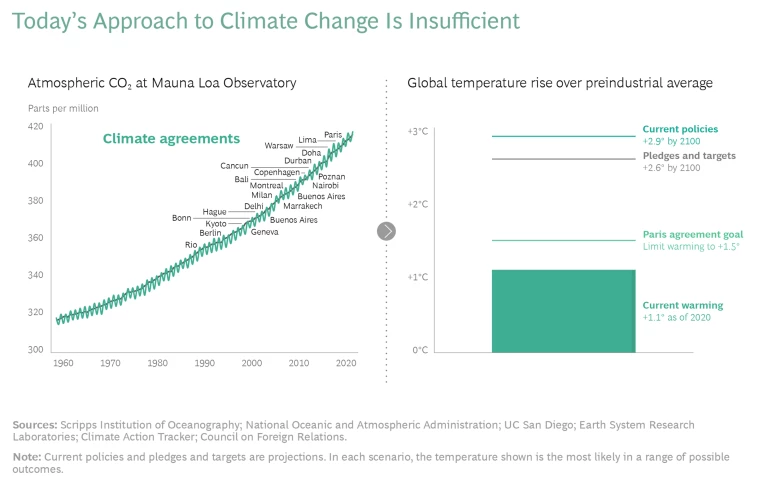The orchestrators of today’s largest technology-enabled business ecosystems are uniquely positioned to help bring about collective environmental action.
Human societies have an outstanding ability to solve complex collective action problems, and for the past 400 years they have done so primarily through the mechanism of the nation-state. However, states have found it especially challenging to tackle collective action problems that are global in scale.
The COVID-19 pandemic made it clear both how much power states have to act and how difficult it is for them to act in concert when challenges transcend national borders. COVAX, the international effort to ensure equitable access to COVID-19 vaccines, has shipped more than 365 million doses to some of the world’s poorest
State-led collective action on a global scale is even more constrained in response to complex challenges on longer timescales—which is precisely the case with climate change, arguably the greatest known existential threat humanity faces. We know that environmental degradation will have devastating consequences, but because harm materializes progressively over the course of decades rather than days or weeks, we have been less willing to take decisive
While there is no question that states must play a central role in climate action , we need to mobilize every resource available—including the power of private enterprise.
We think there is reason to be optimistic about the business community’s ability to act collectively to tackle climate change. But rather than resting content with individual company “net-zero” pledges and efforts, we should leverage the sophisticated coordination mechanisms that enable thousands of independent companies to participate in today’s business ecosystems. The governance model behind today’s largest technology-enabled business ecosystems can be a powerful tool for global climate action. The few orchestrators at the heart of those ecosystems have the ability and the strategic opportunity to mobilize thousands of businesses across the world in ways that few (if any) other existing coordination mechanisms can match. This will not solve all of our problems, but it could meaningfully accelerate progress.
Why We Need Collective Business Action
Many businesses are already taking action on climate change at an individual level. At least one-fifth of the world’s 2,000 largest public corporations have adopted some kind of net-zero greenhouse gas (GHG) emissions
For starters, CO₂ emissions continue to rise despite the growing number of climate agreements and pledges. Additionally, even if we did manage to deliver on all the pledges and targets that governments and businesses have committed to, global temperature is expected to increase well above the goal set by the Paris Agreement. (See the exhibit.)
To complicate matters further, we lack clear, shared standards for how countries and businesses should pursue their net-zero ambitions, and we have no robust scorekeeping system to assess and track climate action plans. Among the 43% of Russell 1000 companies that have disclosed a commitment to reducing emissions, only 9% have set commitments that meet the Science Based Target Initiative (SBTi) scenario to limit global warming to 2 °C above preindustrial levels by
The problem of translating lofty pledges into concrete plans that can be evaluated, measured, and compared is further complicated by the fact that individual companies may have nonadditive climate effects. Net-zero strategies defined by individual businesses could even have detrimental aggregate outcomes in some cases. For example, companies pledging net-zero emissions very often adopt “offset” strategies that rely on carbon trading. Highly carbon-intensive businesses could thereby become net-zero in a technical, accounting sense—without any actual reduction in the overall amount of carbon that is released into the atmosphere. The offset strategy is constrained by the economics of carbon trading; it will only work until the price of carbon matches or exceeds the cost a business is willing to incur to honor its net-zero pledge. As the price of carbon rises, it is hard to tell whether individual businesses that have adopted the offset strategy will be driven to transform their business models—or just renege on their environmental commitments.
Net-zero strategies defined by individual businesses could even have detrimental aggregate outcomes in some cases.
Even when businesses do change the ways in which they operate to curb emissions, they may nullify their own contributions if they fail to act in concert with others. For example, it is estimated that a 10% reduction in vehicle weight could result in 6% to 8% fuel economy improvements. One way to achieve that is by replacing cast iron and traditional steel with lighter materials such as
As things stand, states have made progress toward setting global emissions targets, but those targets are vague, progress is difficult to measure, and enforcement is virtually impossible. Some businesses, especially large enterprises, have committed to contribute their share—but in aggregate these individual efforts could easily be insufficient. What is required is collective business action of the sort that the business ecosystems of the digital age are uniquely positioned to enable, especially through the agency and activism of their orchestrators.
The Power of Orchestrators
In our previous work , we have defined business ecosystems as dynamic groups of largely independent economic players that create products or services that together constitute a coherent solution. In short, ecosystems are a way for independent businesses to organize in order to realize a collective value proposition. The lesson to be learned from the expansion and proliferation of business ecosystems is that independent enterprises can, under certain conditions, successfully coordinate a very complex set of actors and activities to create value, without relying on command-and-control hierarchies.
While business ecosystems are diverse, their governance structures exhibit some key commonalities. Ecosystems are modular in that their components—the multiple businesses that contribute to them—are independent yet function as an integrated whole, at least for purposes of delivering a joint solution. Most importantly, ecosystems are held together by “orchestrators” that, despite having considerable power over the structure and workings of the ecosystems, nevertheless do not deploy hierarchical control of activities, as is the case in most individual enterprises and vertical supply chains.
Orchestrators are the central nodes of coordination that make an ecosystem’s collective value creation possible. They typically build the ecosystem and its coordinating platforms, encourage others to join, define standards and rules, and act as arbiters in cases of conflict. Some of today’s most successful ecosystems (as in the cases of Alibaba, Amazon, Apple, Tencent, Facebook, and Yandex) are built around orchestrator-owned digital platforms. Because of their place at the heart of ecosystems that can synthesize hundreds and even thousands of contributors, orchestrators wield extraordinary influence; they have the power to shape behaviors across far-reaching networks of partners, often on a global scale.
Ecosystem orchestrators have the power to shape behaviors across far-reaching networks of partners, often on a global scale.
Our analyses suggest that over the past 20 years, ecosystem orchestrators have grown considerably in size, reach, and power. Among the S&P 100, the number of ecosystem orchestrators has grown from 3 to 22. More importantly, those 22 orchestrators account for 40% of the total market value of the S&P 100. The rise of ecosystems shows also in the share of new “unicorns” associated with them: 23% of the new unicorns between 2015 and 2021 have based their business model on orchestrating a business ecosystem.
These facts illustrate the considerable (and growing) share of economic activity concentrated around ecosystems and therefore the extraordinary reach and coordinating power of their orchestrators. With thousands of contributors of all sizes relying partially or wholly on ecosystems, orchestrators have become critical nodes in some of the world’s largest and most complex coordination systems.
How Ecosystems Can Simplify the Challenge
Business ecosystems can enable ambitious climate action, essentially because they simplify the collective action problem we face. Instead of having to coordinate across thousands of enterprises globally, action by a handful of powerful orchestrators can have outsized effects because it can directly shape the decisions of their ecosystems’ contributors.
Consider the case of Amazon, which according to Marketplace Pulse has approximately 1.5 million active
When dealing with climate change, a drastic reduction in the number of key players whose decisions are pivotal can transform the game.
One important virtue of business ecosystems is the sheer diversity of contributors who can come to act collectively through the influence of orchestrators. More specifically, ecosystems reach large numbers of small and medium-size enterprises—those that are less likely to make public net-zero pledges or indeed take any unilateral climate action. Yet the “long tail” of small and medium enterprises (SMEs) all over the world is critical to truly addressing climate change collectively, because SMEs account for 90% of all businesses, 50% of employment, and more than 40% of GDP
In a sense, ecosystems can realize the idea of “climate clubs” proposed by Nobel Laureate William D. Nordhaus. Collective action around climate change is especially difficult because of the free-rider problem: those who undertake costly mitigating action create benefits from which no one can be excluded, so those who do nothing can ride for free. To solve the free-rider problem, Nordhaus proposes that countries should create “club regions” such that “the dues to the club are expensive [emissions] abatement, while the penalties for nonmembership are tariffs on exports to the club
Business ecosystems have another important qualifying characteristic: the ability to unlock experimentation and innovation toward new solutions. An important aspect of the climate challenge problem is that we do not currently know all of the eventual solutions; we must iterate our way toward them. Climate change is as much a challenge of innovation as of execution. Any governance mechanism must therefore be evolvable in nature. Individual ecosystems can deploy their modular structures to explore, adapt, and iterate on solutions; through digital platforms, learning can be fast and easily spread around for contributor networks to continuously rebalance their approaches to a common problem. As multiple ecosystems do the same, there is the additional benefit of multiple, parallel experimentation.
Furthermore, the robust digital technologies that power most of today’s largest ecosystems can go a long way toward filling the complex “scorekeeping gap” of environmental mitigation. As noted above, today’s net-zero pledges are virtually impossible to evaluate and compare, in part because there are no robust standards on the scope and metrics for emission reduction plans and no continuous flow of consistent data. Digital tools can make the difference in terms of setting clear standards, aggregating progress data, and presenting an accurate picture of progress that also creates transparency over and within an ecosystem.
How Ecosystem Orchestrators Can Make a Difference
To reap the benefits of ecosystem-enabled collective action on climate change, orchestrators will need to adopt rigorous GHG emission standards as integral to the governing norms of their ecosystems. They can thereby mobilize the thousands of contributors in whose interest it is to retain access to the ecosystem. While many orchestrators—including Amazon—are already mobilizing businesses in their own supply chains, we are talking here about something more ambitious because the vast set of contributors to Amazon’s ecosystem reaches well beyond the confines of their own operations.
So how could this work? We think there are a few concrete steps orchestrators can take.
Assess ecosystem-level climate impact. Orchestrators should think about all the upstream and downstream activities associated with either their business or their contributors’ businesses. Where are the most salient environmental impacts and risks? What clusters or types of contributors are responsible for the highest rates of energy use or GHG emissions? What is the total footprint of the ecosystem? It is already standard practice among some of the world’s largest businesses to track the environmental impact across their
supply chains
. Apple, for instance, reports a total carbon footprint of 22.6 metric tons of CO₂, of which 71% is associated with the entire product manufacturing value chain, including its
Map and understand the network of contributors. Orchestrators could in parallel develop a clear map of their business partners to identify the contributors and processes that account for the most salient climate impacts and determine where they are. How strong are the relationships with the agents involved? Are they one-off transactions or enduring partnerships? Where is the greatest potential for footprint reduction in terms of size, substitutability, technology adoption, and willingness?
Collaboratively set rigorous targets for the ecosystem. Engage the key players—including large contributors—to agree on what the ecosystem should collectively achieve in terms of climate action. Targets should be bold and backed by hard scientific evidence. Organizations like the Science Based Targets Initiative (SBTi) have the expertise to support orchestrators in their efforts to set the right ambitions and give those goals concreteness (for example, a precise definition of what constitutes net-zero emissions).
Leverage coordination power. Orchestrators have the power to steer an ecosystem toward decision-making principles that incorporate a rigorous dimension of sustainability. For instance, they can require contributors to adopt certain standards or practices, “advantage” those that more proactively adopt sustainable solutions, and even serve as advisors or knowledge-sharing nodes for contributors to learn from best practices across the ecosystem. This can be especially effective in reaching the long tail of SMEs that are harder to engage directly. Consider, for instance, Alphabet’s decision to make available the cloud technology solution that helped reduce energy utilization for cooling data centers by
Orchestrators could also make transparent to consumers the environmental footprint of different companies and products, thereby creating a new adaptive mechanism for reducing emissions.
Keep action plans adaptable across contributors and over time. Individual ecosystem contributors face very different realities. For example, they may differ considerably in the extent of dependence on fossil fuels, access to clean energy sources, or feasibility of sustainable alternatives to existing business processes. To make collective targets reasonable and achievable, orchestrators need to foster the development of context-specific, science-based action plans for key contributors and empower agents across the ecosystem to design solutions within the bounds set by the ecosystem’s shared parameters. This decentralization of action while retaining norm-setting influence at the core can make the ecosystem both powerful and adaptable.
Design shared and actionable monitoring and reporting standards. Orchestrators, especially those that lead
digital ecosystems
, can harness the power of technology to create transparency and accountability. Technology can help build trust by gathering and communicating accurate information about the ecosystem’s environmental impact, system-wide as well as company-level. It is important, however, that technology not be used with merely a compliance mindset but with a strong action and impact bias as well: agents across the ecosystem should learn from the decentralized experimentation and real-time efficacy of environmental efforts across the network.
Why Orchestrators Should Act Now
The existential urgency of climate change should be sufficient reason for orchestrators to take action, leveraging their position at the core of today’s ecosystems for the good of everyone. But there are also strong strategic reasons why orchestrators should do so—and do it now.
As we have noted elsewhere , one of the key principles of corporate longevity and resilience is “embeddedness”, the alignment of a company’s goals and activities with those of the broader systems within which it operates. An enterprise is not poised for long-term success, or even survival, if it works against the goals and aspirations of society at large. Indeed, there are strong signals that some of the world’s largest digital ecosystem orchestrators are increasingly at risk in this regard. Regulatory pressure aimed at curbing the power of digital ecosystem orchestrators over contributors is on the rise:
- A US judge ruled in September 2021 that Apple could no longer force its developers to use the company’s payment system in apps.
- Amazon has come under increasing scrutiny for the terms on which it transacts with its ecosystem contributors (third-party sellers on its retail platform), becoming the target of an ongoing investigation by the EU competition commissioner.
- Alibaba was recently fined $2.8 billion by Chinese regulators, on grounds that it unduly prevented merchants (contributors to its e-retail ecosystem) from selling on other platforms.
The regulatory pressure on digital ecosystem orchestrators is part of a broader
challenge to the legitimacy of globalization and technology
. Between 2010 and 2019, the share of people in the US who believed that tech companies had a positive impact on society decreased from 68% to
In this context, turning ecosystems into active instruments for climate action can be a powerful reaffirmation of corporate purpose that is compatible with societal expectations and goals. Moreover, technology can here be robustly deployed for good, making sustainability pledges tangible and measurable for thousands of enterprises. Orchestrators can draw on what they already know how to do—build and sustain business ecosystems—to make substantial contributions in the effort to combat climate change, thereby renewing their “social license to operate.”
Creating environmental transparency can help orchestrators manage some of the risks they face today. But in so doing, they can also unlock a source of competitive advantage for the future. Orchestrators stand to gain by offering consumers a moral choice on something that they care deeply about and will care even more about over time.
Climate change is so urgent a challenge that we cannot afford not to try everything that could avail. While governments continue to mobilize, business ecosystems can become important complementary mechanisms for collective environmental action. Ecosystem orchestrators are uniquely positioned to bring this about. In short, they have the power to rebuild trust in the extraordinary problem-solving power of business.











